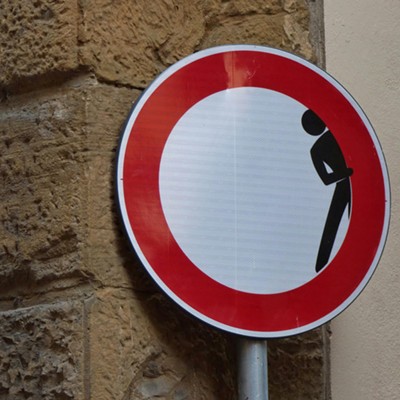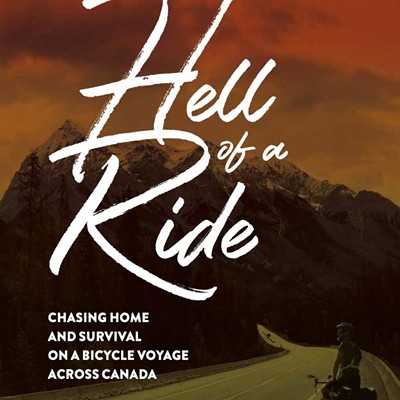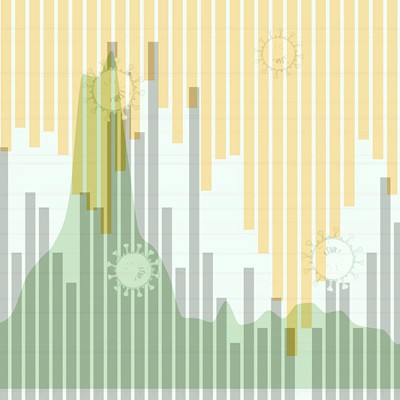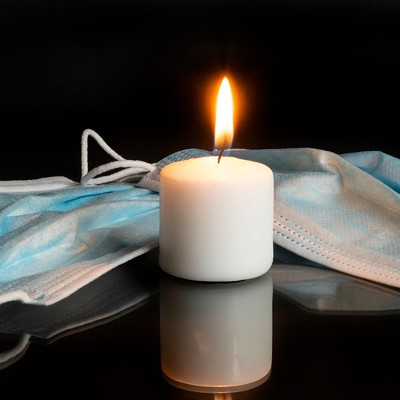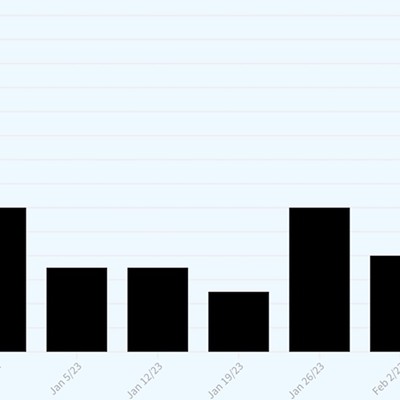NOTE: This week is now over. For the very latest news, please go here. But for an informative look back at exactly how Nova Scotia responded to COVID-19 in realtime, keep on reading.
Editor's note: In its 28 years The Coast has never been a just-the-facts news service, but for these strange times here are quick-hit updates.
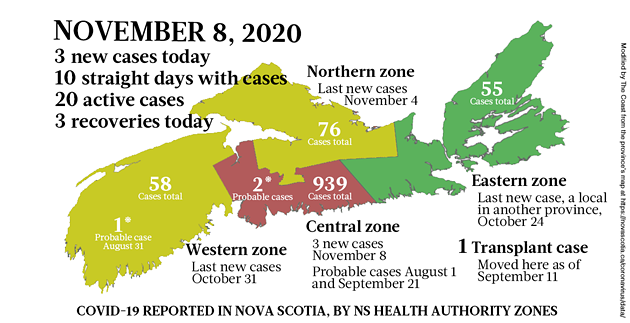
Wave hello
There are three new cases in today's COVID-19 report from the province: "The new cases are in Central Zone. All three cases are under investigation." This makes 10 straight days with fresh infections, for a total of 26 cases.
The last time Nova Scotia had a 10-day stretch with that many cases was up to and including May 22, as the first wave was waning. Now it feels like our second wave has started. This is fully two months later than it got to the provinces west of the Atlantic bubble—an endorsement of the local approach—but it's earlier than any of us want.
An unwelcome hallmark of the second wave is that it can hit harder than the first wave. During the worst of the pandemic last spring, for example, the six provinces from BC to Quebec had a total of just over 24,000 cases in two weeks; today that number is essentially double, a hair under 48,000 cases. If Nova Scotia really is facing the second wave, it has a long way to go before it will rival the first wave. Our record one-day high is 55 new cases, set April 23. The most we've had lately is 5 in a single day. Our record for active cases is 466 on April 19, peak first wave. Today we have 20 active cases, the most in over five months, but nowhere near 466.
The east coast has been so lucky for so long, relatively untouched by the disease since June, it's hard to imagine current case levels going higher than anything we've yet seen. Which is probably what regions all over the world said before the hospitals started filling up again, before schools sent students back home, before strictest-ever lockdowns took effect. Nova Scotia isn't there yet—none of the currently infected patients are even in the hospital—and premier McNeil wants to keep it that way.
"We cannot become complacent about this virus," McNeil said in the province's update. "That means we all must continue to follow public health protocols, including social distancing, wearing a mask, proper hand hygiene and limiting social contacts."
Strang is still not calling any of the latest infections community spread, although with more cases getting announced without a travel connection, and more warnings of potential exposure coming out, he's doing more dancing around the term. "As positive cases are investigated public health may learn a person spent time in community settings, like a restaurant, while infectious or potentially infectious," he said in the update. "If they are unsure that all contacts have been found, they use a public exposure notice to ensure everyone that may have been a close contact is aware and monitoring their health or getting tested if directed."
In another C19-related increase, Strang and McNeil are giving a webcast briefing tomorrow at 3pm. These sessions tapered from daily during the first wave to about twice a month; this will be the second in a week, after last Tuesday's session, a rate that definitely shows their growing concern. You can watch live at novascotia.ca/stayinformed/webcast, or catch it later at the Nova Scotia government's YouTube page.
Today's positive news is that three recently infected C19 patients have recovered. Plus the Eastern health zone (Antigonish, Cape Breton) has gone a full two weeks without a case, so it reverts to a chill green on our case map.
We got cases, the US got a new president
Nova Scotia's COVID-19 update brought news of four new cases and no recoveries. "The new cases are in Central Zone," says the report. "Two cases are related to travel outside Atlantic Canada. The other two cases are close contacts of previously reported cases."
Soon after that depressing report, however, the world got a modicum of relief because American media declared Joe Biden as the next US president. It's a relief from watching coverage of vote counting. A relief from a global leader who's actively working against climate and epidemiological science. And just maybe a relief from the most C19-infected country on the planet acting in many ways as if there's not a pandemic happening. With any luck, Biden will act as a coronavirus vaccine.
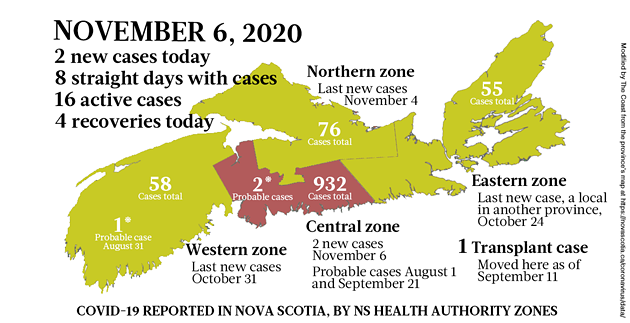
The disease won this week
Every day since last Friday, there has been at least one new case of COVID-19 in Nova Scotia, and today's no exception. The province is reporting two cases. Both are in the Central health authority zone—the large region that includes Halifax.
Another commonality is that neither can be easily explained as travel-related. "One case is a close contact of the case reported Thursday, Nov. 5. Those linked cases remain under investigation," says the province's report. "Today's other case is also under investigation."
Four people who were recently diagnosed with C19 recovered since yesterday. That's a plus. But still, the numbers this week are going in the wrong direction. There have been 19 cases since last Friday, and only seven recoveries. Nova Scotia could be Donald Trump.
Before this recent rash of infections, Nova Scotia went two whole months—from August 29 to October 29—and only racked up 19 infections.

The good news first
Two people who got COVID-19 have recovered since yesterday's provincial report. And Nova Scotia's labs just completed 1,058 tests for the disease, a single-day high that hasn't been matched since September 26, so it looks like people are taking the threat of the second wave seriously enough to get their easily disregarded runny noses and sore throats and fevers and coughs and headaches and breathing troubles checked out.
Like top doc Strang always says, aggressive testing and contact tracing is a key component of Nova Scotia's strategy for getting through the pandemic safely. (The other two legs of that strategic stool are the quarantine on travellers, and people using the individual protection measures like wearing masks, washing hands, physical distancing, et cetera).
In other news, Nova Scotia has one new case diagnosis. "The new case is in the Central Zone and is under investigation," says the daily update from the province. As we've discussed earlier in the week, "under investigation" is code for "right now we don't know how this person got infected, but we're gonna contact trace the heck out of this case to see if there's a travel connection or another infection we can tie it to because we don't want it to be community spread any more than you do."
At the surprise briefing Tuesday, Strang said the recent "under investigation" cases actually have some sort of connection to travel and each other, and don't represent true, out-of-control community spread. Today's provincial report does not say if the new case is connected to those other cases; maybe that's what the investigation will determine, or maybe the public health peeps already know there is no connection. We've asked the province for details, and will let you know what we find out.
Quadruple threat
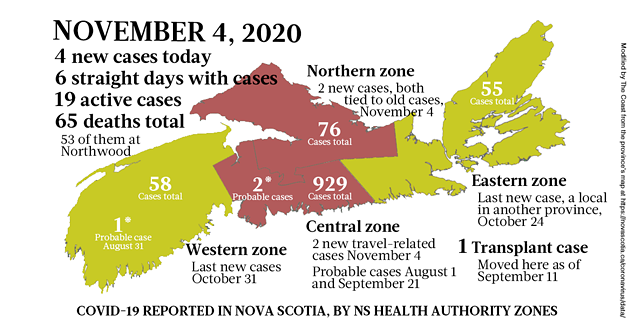
The province is reporting four new COVID-19 cases. That's the sixth day in a row Nova Scotia's had fresh infections. As we said yesterday, the last time cases hit so relentlessly was in May. Back then, the streak went for 16 days without a break.
The four cases are evenly divided between the Central and Northern health zones. The pair in Central are people who "travelled outside of Atlantic Canada together," says the province's C19 update, while the Northern two "are household contacts of a previously reported case." It's good news that the sources of infection are so clear.
And there's more good news hidden in the provincial report: one patient who got infected recently has recovered. We now have 19 people known to be actively fighting this dumb disease.
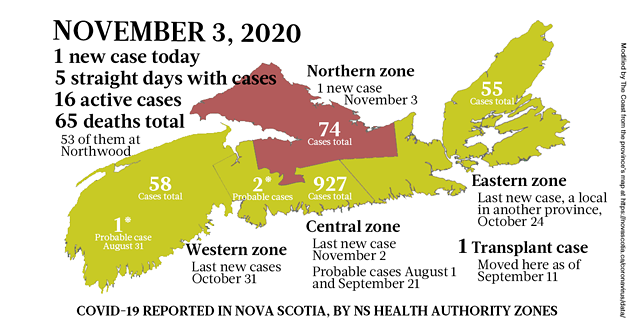
Streaking cases
Today's new case—it's in the Northern health zone—marks five days in a row that Nova Scotia has reported cases. This is exactly the wrong sort of streak. The last time we had a string of diseased days this long was in May.
According to the province's COVID-19 update, today's case "is currently under investigation by public health." We've written a lot in the last couple days about what it means—or might mean—when a case can't be easily described as travel-related. (See below.) Top doc Strang and premier McNeil had a briefing today, and Strang also gave some attention to this issue. We are still processing the briefing, aiming to write up an explanation for you soon, but the reassuring bottom line is that Strang doesn't think we are facing community spread of C19. Yet.
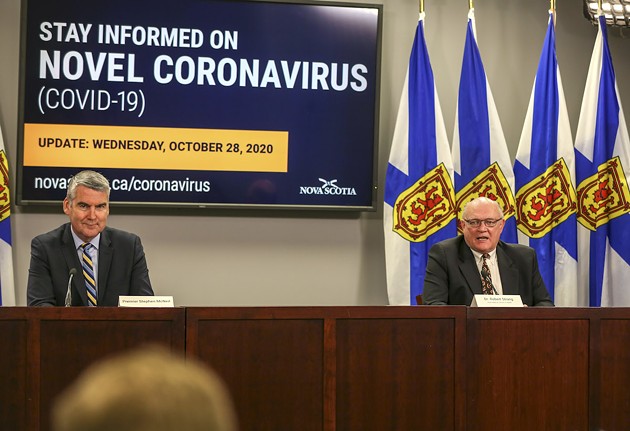
A surprise briefing
Top doc Robert Strang and premier Stephen McNeil used to give webcast COVID-19 media briefings every day but Saturday. That's when the pandemic was new and our case numbers were high. Daily updates offered comfort and a sense of control to locked-down Nova Scotians, not to mention useful information. But as we curbed the virus and the province adjusted to a relatively disease-free life in the safety of the Atlantic bubble, the pace of briefings slowed, and McNeil's reputed aversion to the transparency and predictability of a public schedule asserted itself.
Now Strang and McNeil have settled into a pattern of doing a briefing about once every couple of weeks, on Wednesday. However, that's not an official schedule—there is no official schedule—so every time the province sends out an email to media announcing a briefing the next day, it's hard to know if there's some crisis or this is a routine check-in. Lately the Wednesday briefings have tended to be routine.
There's a briefing today at 1pm, however, that seems more critical. It breaks the two-week pattern (the last briefing was just six days ago), and it was announced yesterday, between news of a third C19 case that suggests community spread and potential exposure at a downtown Halifax gym. You can watch live at novascotia.ca/stayinformed/webcast, or catch it later at the Nova Scotia government's YouTube page.

Is this community spread?
There aren't too many ways for COVID-19 to turn up in Nova Scotia. There's travel, when someone brings the disease here from someplace else. And there's connection to a known case, like when your roommate gets back from a trip and you decide to quarantine together and you both wind up with C19, or you're a nurse who cares for C19 patients and you catch it on the job, or you happened to be at the gym the same time as a C19 patient and thanks to a public health advisory you figure out that must be how you got infected.
Then there's community spread, the scariest kind of spread. You have no idea how you got the disease, and the public health investigators who do contact tracing can't track it down. Community spread is not a straight line of connections that can be followed and blocked—from traveller to roommate; from infected plane passenger to nearby passenger to cab driver to the taxi's next passenger; from bench press woman to elliptical guy. Instead, community spread resembles the coronavirus itself, with its nubs pointing in every direction at the same time.
When the province announces cases, it also tends to indicate the infection route. Lately, the cases have almost all been related to travel outside Atlantic Canada, which is reassuring because almost all of those travellers were in quarantine for two weeks, limiting spread by keeping patients isolated while their symptoms developed.
Some travellers are exempt from quarantining—essential workers, for example—and we've all heard of some travellers who don't bother taking the self-isolation requirement strictly, because people can be assholes. But mostly the quarantine system has worked to avoid community spread. And the province is rightly making a point that it's working by letting us know when a new case is related to travel (whether it's the traveller or their close contact).
That's why three recent cases are concerning. Sunday's two patients were not described as travellers or travel-related—all the province said is the "new cases are in Central Zone and are under investigation."
Monday brought two more new cases, and a large dose of confusion. "The new cases are related to travel outside of Atlantic Canada," started the province's update, before going on to describe the details of each case. "One is a person in the Northern Zone who self-isolated" after travel, "as required." No problem there.
The other, in the Central health zone, is less straightforward because it's "connected to the two cases reported Sunday," with still no indication of how any of them caught the disease in the first place. "Those three linked cases remain under investigation," the update said.
It doesn't make sense that a case's source can be known as travel-related and yet require further investigation to figure out. The statement that both Monday cases are related to travel could be wrong. The impression that the three linked cases don't have a known source could be wrong. Or something unprecedented is happening. So Monday afternoon we asked the province to clarify.
"At this time, these cases remain under investigation," was the reply, along with a promise of more details to come Tuesday from Nova Scotia public health top doc Robert Strang. An answer that raises a pretty big question. Obviously none of the three patients were on planes lately (travel's got to be at the top of the list of things contact tracers look for). And it's rarely a good diagnosis when it has to be delivered by the doctor. So are we facing community spread?
Strang does not give up easily. He's repeatedly compared contact tracing to detective work—"shoe leather epidemiology" is a thing in public health—and he will take the time to chase down every lead in order to avoid prematurely sounding the alarm of community spread. But clearly the worry is that the three cases are examples of community transmission.
Sure enough, not long after the C19 update was issued Monday afternoon, the province sent an announcement to media about a webcast C19 briefing: "Premier Stephen McNeil and Dr. Robert Strang, Nova Scotia's chief medical officer of health, will provide an update Tuesday, Nov. 3 at 1 p.m." This is an unusual move, breaking from Strang and McNeil's current once-every-couple-weeks-or-so routine. Scheduling an extra briefing all of a sudden is tantamount to calling for an emergency session, despite the announcement's innocuous wording.
And then, less than two hours later, the Nova Scotia Health Authority issued an announcement of its own, warning of "Potential exposure to COVID-19 at Halifax gym on October 26." If you were at Fit4Less (1535 Dresden Row) last Monday between 8am and 10am, you need to watch yourself for C19 symptoms.
Any one of those announcements, on its own, could raise some fear of community spread. Taken together, it's hard not to see them as a giant red flag. A flag Strang and McNeil will doubtless address Tuesday.
Whether they offer reassurance about the ongoing contact tracing investigation, or formally acknowledge that community spread is happening or just explain how a cluster of three cases can somehow be both travel-related and need to be investigated, remains to be seen. They've used past briefings to introduce rules around social gatherings, travel and even the lockdown; it's possible we'll get new restrictions at this briefing in response to the recent rise in cases. Or maybe McNeil and Strang see a useful opportunity to remind Nova Scotians to keep wearing masks, to avoid leaving the Atlantic bubble if at all possible, to follow the rules on travel quarantine when you return. To fight coronavirus complacency, in other words, before it's too late.
Feeling on the brink
Nova Scotia hasn’t had this much COVID-19 activity in a while. Last week there were new cases reported on five of the seven days—a high frequency that has not happened since the middle of August—including the five Saturday cases, the most on a single day in almost six months.
In the big picture, these numbers are low. The C19 second wave is actively swamping much of the world, including the provinces west of the east coast. Quebec and Ontario are each getting around 1,000 cases every day. Nova Scotia’s unusually active week saw a total of just 11 cases, which is low even in the Atlantic bubble, where New Brunswick reported cases every day last week for a total of 18.
Still, it’s hard to shake the feeling something has changed. So far our mandatory two-week quarantine on travellers is working, like a wall of sandbags holding off a rising flood. But the pressure is building at our borders, and some water is seeping through the wall.
The two cases reported yesterday could not be easily dismissed as travel-related, raising concerns that community spread is happening as the contact-tracing investigation continues. The results of that investigation and the daily case numbers will tell us a lot about where this week is heading. Let's meet back here for updates.
News updates archives
October 26 week. October 19 week. October 12 week. October 5 week. September 28 week. September 21 week. September 14 week. September 7 week. August 31 week. August 24 week. August 17 week. August 10 week. August 3 week. July 27 week. July 20 week. July 13 week. July 6 week. June 29 week. June 22 week. June 15 week. June 8 week. June 1 week. May 25 week. May 18 week. May 11 week. May 4 week. April 27 week. April 20 week. April 13 week.




